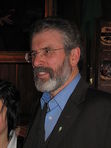Gerry Adams's Blog, page 29
October 24, 2019
Máire Drumm; leader and visionary
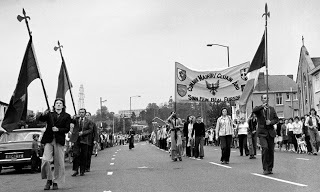 ©Gérard Harlay
©Gérard HarlayThis photo by French photographer Gérard Harlay was taken on 8 August 1976. It shows Bobby Sands on the left carrying the Harp flag and Máire Drumm to the right leading the march. The late Marie Moore is behind Máire carrying a loud hailer.
Tuesday, October 22nd was the centenary of the birth of Máire Drumm. Many readers will know of her. Máire was one of the most courageous aThis week I published a book on Máire. It is the latest of a little series of books in the Leargas series which so far has included folklorist Michael J Murphy, Republican leader John Joe McGirl and human rights lawyer Pat Finucane. I intend to republish a book on Sheena Campbell by Ella O’Dwyer and others in the next short while.
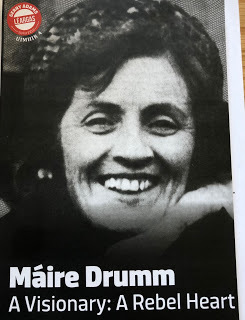 Maire was born Máire McAteer on Kelly’s Road, Killean, in south Armagh on October 22nd 1919. She was the eldest of four children – Christina (Teenie), Tommy and Seán. Máire attended Killean Primary School and later Our Lady’s Grammar School in Newry. When partition was imposed the McAteer family, like many others, found themselves trapped on the northern side of a border they did not want and in a state which did not want them.
Maire was born Máire McAteer on Kelly’s Road, Killean, in south Armagh on October 22nd 1919. She was the eldest of four children – Christina (Teenie), Tommy and Seán. Máire attended Killean Primary School and later Our Lady’s Grammar School in Newry. When partition was imposed the McAteer family, like many others, found themselves trapped on the northern side of a border they did not want and in a state which did not want them.
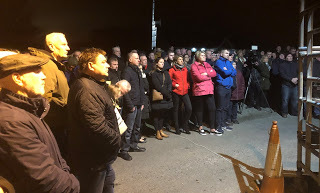 Commemoration on Tuesday night at Kelly's Road
The ditch at the end of the field at the back of her home was the border. For Máire it was an injustice she opposed all of her life. As a teenager Máire enjoyed Camogie and Irish dancing. After leaving school she worked for a time in John Quinn’s shop– The Milestone, which is reputed to have been the first supermarket in Newry. She left for Liverpool when she was 16 in search of work with her sister Teenie. There she joined the Gaelic League. She then moved to Dublin where she lived in Baggot Street. Máire joined Sinn Féin. In 1939 she moved to Belfast where she found work in a grocery shop in the Falls area of West Belfast. Over the next three decades she worked in a series of shops and supermarkets, including as deputy Manager. Máire worked in Quinn’s in Ardoyne, and for Stewarts Cash Stores.Máire was very active as a camog in her local club Gael Uladh. She went on to become the Antrim Secretary and later the chairperson of the Ulster Council of the Camogie Association and All-Ireland Vice Chairperson. Máire was also involved in the McAleer School of Irish Dancing. Later she was prominently involved in planning and raising money for the opening of Casement Park in 1953.
Commemoration on Tuesday night at Kelly's Road
The ditch at the end of the field at the back of her home was the border. For Máire it was an injustice she opposed all of her life. As a teenager Máire enjoyed Camogie and Irish dancing. After leaving school she worked for a time in John Quinn’s shop– The Milestone, which is reputed to have been the first supermarket in Newry. She left for Liverpool when she was 16 in search of work with her sister Teenie. There she joined the Gaelic League. She then moved to Dublin where she lived in Baggot Street. Máire joined Sinn Féin. In 1939 she moved to Belfast where she found work in a grocery shop in the Falls area of West Belfast. Over the next three decades she worked in a series of shops and supermarkets, including as deputy Manager. Máire worked in Quinn’s in Ardoyne, and for Stewarts Cash Stores.Máire was very active as a camog in her local club Gael Uladh. She went on to become the Antrim Secretary and later the chairperson of the Ulster Council of the Camogie Association and All-Ireland Vice Chairperson. Máire was also involved in the McAleer School of Irish Dancing. Later she was prominently involved in planning and raising money for the opening of Casement Park in 1953.
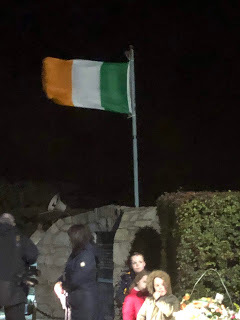 Máire was always very supportive of the republican political prisoners. She was a member of the Green Cross raising money for prisoners and their families. It was common practice then for republicans in Belfast to visit Republican prisoners from outside Belfast, in Crumlin Road prison. It was there that she met Jimmy Drumm. They were engaged before Jimmy was released.Máire and Jimmy were married in St. Paul’s Church on the Falls Road on 16 July 1946. In 1956 Máire and Jimmy got a house in Glassmullan Gardens, in Andersonstown. There they raised their five children – Seamus, Margaret, Seán, Catherine and Máire Óg.December 1956 saw the commencement of Operation Harvest – the IRA Border Campaign. Jimmy Drumm was arrested and held for four years until his release in 1956.In the 1960s a focus on the denial of civil rights saw the establishment of the Civil Rights Association. When the unionist state responded violently in the pogroms of 1969 both Máire and Jimmy were centrally involved in helping the thousands who were forced to flee when their homes were destroyed by marauding gangs of RUC and loyalists.Like many other homes, the Drumm home became a sanctuary for refugees. Máire was instrumental in having La Salle secondary school opened to the refugees. And while Máire was busy helping deeply traumatised families Jimmy was trying with others to secure the weapons needed to defend Catholic areas. The subsequent split within Republicanism in 1969 and 1970 saw Máire and Jimmy support what, for a time, was called the Provisionals. The years that followed were busy ones for Máire and Jimmy. It was a time for courage and leadership and both stepped forward.Despite harassment, death threats, imprisonment and a vicious and scurrilous campaign of hate by the British media Máire refused to be browbeaten or bullied. She led from the front. Sinn Féin was still a banned organisation but Máire simply saw that as a challenge to be overcome.An example of her leadership and courage occurred in July 1970 when the British Army placed the Falls community under military curfew. The streets of small terraced houses off the Falls Road were smothered in clouds of CS gas. Families were trapped in their homes choking from the gas. Three thousand soldiers and armoured vehicles surrounded them. The British soldiers smashed down front doors and wrecked homes, assaulting residents and looting property. Four people died and many more were injured or arrested.People ran out of food. Mothers ran out of baby food. Despite appeals from local clergy the British Army refused to allow anyone to go to the shops. Máire led a march of Belfast women into the Lower Falls, with food supplies for the besieged residents. There is a famous piece of black and white film footage which shows hundreds of women proudly and defiantly marching into the lower Falls and brushing armed British soldiers aside. The curfew was broken.In the years that followed Máire became Leas Uachtarán of Sinn Fein. She was arrested many times and was imprisoned in Armagh Women’s Prison and Mountjoy Prison. She led the campaigns against internment and the ending of political status.
Máire was always very supportive of the republican political prisoners. She was a member of the Green Cross raising money for prisoners and their families. It was common practice then for republicans in Belfast to visit Republican prisoners from outside Belfast, in Crumlin Road prison. It was there that she met Jimmy Drumm. They were engaged before Jimmy was released.Máire and Jimmy were married in St. Paul’s Church on the Falls Road on 16 July 1946. In 1956 Máire and Jimmy got a house in Glassmullan Gardens, in Andersonstown. There they raised their five children – Seamus, Margaret, Seán, Catherine and Máire Óg.December 1956 saw the commencement of Operation Harvest – the IRA Border Campaign. Jimmy Drumm was arrested and held for four years until his release in 1956.In the 1960s a focus on the denial of civil rights saw the establishment of the Civil Rights Association. When the unionist state responded violently in the pogroms of 1969 both Máire and Jimmy were centrally involved in helping the thousands who were forced to flee when their homes were destroyed by marauding gangs of RUC and loyalists.Like many other homes, the Drumm home became a sanctuary for refugees. Máire was instrumental in having La Salle secondary school opened to the refugees. And while Máire was busy helping deeply traumatised families Jimmy was trying with others to secure the weapons needed to defend Catholic areas. The subsequent split within Republicanism in 1969 and 1970 saw Máire and Jimmy support what, for a time, was called the Provisionals. The years that followed were busy ones for Máire and Jimmy. It was a time for courage and leadership and both stepped forward.Despite harassment, death threats, imprisonment and a vicious and scurrilous campaign of hate by the British media Máire refused to be browbeaten or bullied. She led from the front. Sinn Féin was still a banned organisation but Máire simply saw that as a challenge to be overcome.An example of her leadership and courage occurred in July 1970 when the British Army placed the Falls community under military curfew. The streets of small terraced houses off the Falls Road were smothered in clouds of CS gas. Families were trapped in their homes choking from the gas. Three thousand soldiers and armoured vehicles surrounded them. The British soldiers smashed down front doors and wrecked homes, assaulting residents and looting property. Four people died and many more were injured or arrested.People ran out of food. Mothers ran out of baby food. Despite appeals from local clergy the British Army refused to allow anyone to go to the shops. Máire led a march of Belfast women into the Lower Falls, with food supplies for the besieged residents. There is a famous piece of black and white film footage which shows hundreds of women proudly and defiantly marching into the lower Falls and brushing armed British soldiers aside. The curfew was broken.In the years that followed Máire became Leas Uachtarán of Sinn Fein. She was arrested many times and was imprisoned in Armagh Women’s Prison and Mountjoy Prison. She led the campaigns against internment and the ending of political status.
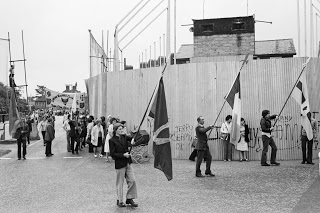 ©Gérard Harlay
Bobby Sands in the foreground carry the harp flag. Jimmy Roe in the middle and Kevin Carson on the far side. Máire can be seen on the left.
On 8th August 1976 Máire led the first big political status march in Belfast. Gérard Harley a French photographer sent Tom Hartley a large archive of photos from the 1970s. Richard McAuley scoured this archive and others for photos of Máire for the new book. To our great delight we discovered previously unrecognised photos of Bobby Sands, including one on the Andersonstown Road which clearly shows Bobby, Máire and Marie Moore with a loud hailer.On October 28th1976, just days after she had celebrated her 57 birthday loyalist gunman entered the Mater Hospital where she was being treated for an eye problem and shot and killed her.
©Gérard Harlay
Bobby Sands in the foreground carry the harp flag. Jimmy Roe in the middle and Kevin Carson on the far side. Máire can be seen on the left.
On 8th August 1976 Máire led the first big political status march in Belfast. Gérard Harley a French photographer sent Tom Hartley a large archive of photos from the 1970s. Richard McAuley scoured this archive and others for photos of Máire for the new book. To our great delight we discovered previously unrecognised photos of Bobby Sands, including one on the Andersonstown Road which clearly shows Bobby, Máire and Marie Moore with a loud hailer.On October 28th1976, just days after she had celebrated her 57 birthday loyalist gunman entered the Mater Hospital where she was being treated for an eye problem and shot and killed her.
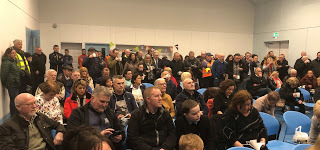 On Tuesday evening at her homeplace in South Armagh we celebrated her life. We remembered the exceptional human being who in difficult and challenging times, and at great risk to herself, stepped forward to give leadership.The threats, the arrests, the periods of imprisonment never deterred Máire. Never broke her spirit or her determination to achieve an end to partition and a united Ireland. That was Máire Drumm.The book:
Máire Drumm A Visionary: A Rebel Heart
is now available in the Sinn Féin bookshop and online at www.sinnFéinbookshop.com
On Tuesday evening at her homeplace in South Armagh we celebrated her life. We remembered the exceptional human being who in difficult and challenging times, and at great risk to herself, stepped forward to give leadership.The threats, the arrests, the periods of imprisonment never deterred Máire. Never broke her spirit or her determination to achieve an end to partition and a united Ireland. That was Máire Drumm.The book:
Máire Drumm A Visionary: A Rebel Heart
is now available in the Sinn Féin bookshop and online at www.sinnFéinbookshop.com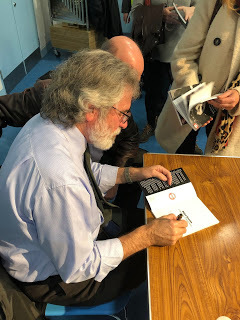
Published on October 24, 2019 03:45
October 18, 2019
Ulick O Connor – Patriot
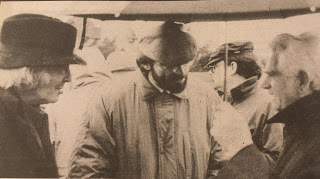
Ulick, mise agus Paul 'ODwyer with Tom Hartley in the background
Ulick O Connor died last week in the nursing home where I last saw him in August. I intended to visit him last week when I got word of his death. I first met Ulick in the 1980s. I was scheduled to speak at a debate in Cork University on a motion along the lines of ‘This House accepts that armed struggle in the north is a legitimate response to military occupation.’ That may not be the exact words but it’s the gist of it. As the date of the debate came closer I was told that the university society involved was having difficulty getting anyone else to speak in support of the motion. Then Ulick stepped in. He was very well known by then because of his frequent appearances on the Late Late Show and his passionate republican defence of the nationalist position – a rare enough occurrence in those revisionist days.
After the debate – which we won – I got my first experience of Ulick’s legendary argumentiveness. Five or six of us were packed into a small car. Ulick was in the back with some Cork republicans. I overheard one of them saying he had no time for Tom Barry, the legendary IRA guerrilla leader.
‘Why?’ Ulick asked.
‘He took the Freestate pension’. Our unfortunate Corkonian replied.
‘He did much more than that!’ Ulick exploded before launching into a heated defence of Tom Barry and a fiery denunciation of Irish begrudgery and small mindedness.
I thought the argument was going to descend into fisticuffs. It was lucky for all involved that it didn’t. Ulick was a noted sportsman. Along with pole vaulting, soccer, rugby, cricket and running he was a British and Irish Universities Welter weight boxing champion. There are many stories of Ulick’s contrariness, his pernickety nature, his quick temper. I have to say I never had an argument with him. I also have to say that he was a great argumenter.
He was a barrister, a writer, an actor, and literary critic, a pundit, a newspaper columnist, playwright and a poet. He loved words. He was an authority on Oliver St John Gogarty, WB Yeats, Brendan Behan, James Joyce and the other greats of the Irish literary world. Celtic Dawn; A portrait of the Irish Literary Renaissance, published in 1984, took eight years for him to write and is the story of the literary revival told through the biographies of its leading lights. Ulick was on the board of the Abbey Theatre and a member of Aosdána. When he died just before his ninety first birthday, a library died with him.
He was an independent thinker. He was proud of his great grand father, the Fenian and Parnellite MP Matt Harris. He wrote a book on Michael Collins. When the Dublin establishment, including many from the Arts, were silent on the North or tolerated censorship Ulick was outspoken.
He was a regular visitor to Belfast. On one of his first visits I took him to Springhill. By complete fluke some young boys were playing with what was probably the only rugby ball in West Belfast. Ulick was delighted with this and often recounted that story. On another occasion he and some of his friends travelled over to hear Ian Paisley preach in East Belfast. Afterwards Ulick told Mr Paisley that he considered him to be one of the last of the great Irish orators. He was pleased that both these compliments were accepted cheerfully by the Free Presbyterian leader.
Ulick was a great supporter of Féile An Phobail. He and Tomás Mac Anna, Artistic Director of the Abbey Theatre, brought one of Ulick’s plays Executions to Féile. The cast of professional and locally recruited amateur actors excelled themselves in this drama about the Irish civil war and the summary executions of four republican prisoners by the new Freestate regime following the IRA killing of a government TD.
In an introduction to the text Ulick wrote: ‘A decolonised people inherit many confused conditioned reflexes from centuries of being governed by an imperial power. The working of these reflexes out of the national mind is a painful process and, it would seem, a long one’.
Little surprise then that Ulick supported the Blanket men and the women in Armagh. Of Bobby Sands he wrote: ‘Any man that will suffer for his principles is a person the human race needs to succeed.’
In July 1981 he was one of those who handed a petition into the British Embassy in Dublin after a march in support of the hungerstrikers. That demo was attacked by Garda riot squads. In his introduction to Bobby Sand’s, Skylark Sing Your Lonely Song, published by Mercier, Ulick wrote that the hungerstrike; ‘brought the truth of his (Bobby Sands) people’s predicament before the world. It was the Irish mind against the English one….’
Ulick was a regular visitor to Sinn Féin Ard Fheiseanna. He always arrived early for the Party Presidential Address. Once he seated himself in the section reserved for the Diplomatic corps. He then refused to move despite many entreaties from the party managers. He and I met regularly over the years for lunch, especially since I was elected to Leinster House and around Dublin more often. Then when he was less well we got together in his home or later again in the hospital and in the nursing home. We discussed politics and books in equal measure. I always enjoyed his company, his curiosity, his knowledge of writing and writers, his wisdom and insights into the Irish character, his fiery commitment to Ireland and his contempt for what he considered the hypocrisy of the ruling elites.
I am glad I knew Ulick. My condolences to his family and friends, particularly Mary his niece and Anna Harrison. After his death I read that his wish was to be remembered; ‘as having written one good poem or one good book that would outlast me’.
There are many of these. I offer this one because I think Ulick O Connor would like me to conclude my tribute to him in this way. I think he would think it a fitting end. I certainly do. Go raibh miath agat Ulick.
Message from H-Blocks - Ulick O’ConnorThinking of Apollo who went down among the swineherdsAnd of One who elected to be born in a stable,I thought of those in Belfast who traced excrement on their cell wallsTo send the world a message along the spirit’s cable.Then the final throw, the refusal of sap to the body,The mind roaring along swerved avenues of agony,Bishops shanghaied to tell them their soul was in dangerAs the jailers discovered the value of Catholic theology.That they should let you die rather than wear your own jacketDefines the jackboot under that affable decorum.Let it not be forgotten that this summer the Teagues in Belfast,Out of the body’s agony, made the world their forum.(May-August 1981)
Published on October 18, 2019 03:37
October 11, 2019
Time for Unity
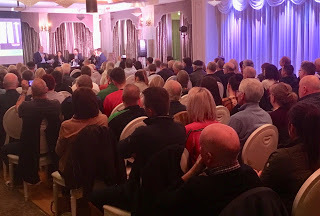
Carrickdale Hotel
Last Thursday evening, in the midst of Storm Lorenzo, hundreds of citizens braved the weather and turned out to the Carrickdale Hotel on the border for a conference on Brexit. It was organised by Martina Anderson MEP and Mickey Brady MP. The conference room was packed to capacity. It was an informative conversation just days after the British Prime Minister Boris Johnson published his self-proclaimed ‘workable alternative’ proposals to the Backstop.
The Johnson proposals are dangerous and reckless. They will undermine the institutional and all-island structures, as well as the human rights principles, which are the strengths of the Good Friday Agreement.Any proposal that will establish checks along the border is unacceptable. Any proposal that requires two borders on the island of Ireland is a fantasy. The alignment proposal would mean that significant elements of the all island economy would be outside the single market and customs union. It is woefully inadequate.Moreover, Mr. Johnson plans to hand a veto to the DUP over all of this. A veto that can be exercised every four years. A veto, not only over the future of the economy in the North, but of the island of Ireland. This is a disgraceful and unacceptable proposal.In short Johnson’s proposals are unworkable, impractical, and irresponsible. And no Irish government, and no Irish Taoiseach can sign up to these proposals or anything approximating to them.As this column is published there are just three weeks left to Johnson’s ‘no is or buts’ deadline of October 31st.
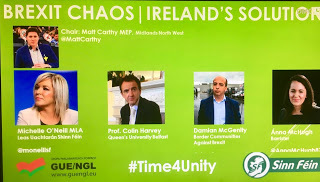 Brexit presents many challenges, but also opportunities. Principal among these must be achieving the objective of Irish unity and winning the referendum on unity which is the mechanism to secure this. It is important for republicans to understand that we are in the national liberation stage of our struggle. As republicans and socialists we also understand that without national freedom and an end to British rule we cannot build the Ireland envisaged in the 1916 Proclamation and the Democratic Programme of the First Dáil.A century ago James Connolly was right when he urged Labour to oppose partition. He recognised that partition would divide more than the land of Ireland. It would also divide the working class and worker from worker. This is not just some old adage or slogan that can be trotted out when we want to remember Connolly. His analysis in 1914 that working class unity is only possible in the absence of partition is just as valid today as it was then.Connolly wrote:
‘Such a scheme (partition) as that agreed to by Redmond and Devlin, the betrayal; of the national democracy of industrial Ulster would mean a carnival of reaction both North and South, would set back the wheels of progress, would destroy the oncoming unity of the Irish labour movement and paralyse all advanced movements whilst it endured’.
Connolly was also right when he identified the national and social as opposite sides of the one coin. Complementary not contradictory. That’s what marked him out from other progressives. That’s what should mark republicans out today.Sinn Féin is the uniting Ireland party. It is this which distinguishes us out from all of the other parties. Some who espouse socialism and left politics fail to comprehend the connection between Irish Unity and the implementation of socialist policies by a government. This is a serious flaw. Sinn Fein activists must work hard to educate ourselves and others, to inform and to be active on Irish Unity and ending the union as a worthy objective in its own right as well as a necessary prelude to a real republic.We are back to Tone and the need to unite Catholic, Protestants and Dissenters as the means of breaking the connection with Britain and we are back to Connolly’s reconquest of Ireland by the people of Ireland. Bobby Sands understood this. He wrote: ‘The day will dawn when all the people of Ireland will have the desire for freedom to show. It’s is then we will see the rising of the moon”. The fact is there is going to be a referendum on unity. This – and the ending of the Government of Ireland Act - was one of Sinn Féin’s main achievements in the Good Friday Agreement negotiations in 1998. Since then, and understandably, the party has been consumed by efforts to nurture the peace and political process and the many challenges this has thrown up. This has involved our work in representative forums; Stormont, Leinster House, the European Parliament, Westminster, local Councils, as well as efforts to grow the party and make it fit for purpose.
Brexit presents many challenges, but also opportunities. Principal among these must be achieving the objective of Irish unity and winning the referendum on unity which is the mechanism to secure this. It is important for republicans to understand that we are in the national liberation stage of our struggle. As republicans and socialists we also understand that without national freedom and an end to British rule we cannot build the Ireland envisaged in the 1916 Proclamation and the Democratic Programme of the First Dáil.A century ago James Connolly was right when he urged Labour to oppose partition. He recognised that partition would divide more than the land of Ireland. It would also divide the working class and worker from worker. This is not just some old adage or slogan that can be trotted out when we want to remember Connolly. His analysis in 1914 that working class unity is only possible in the absence of partition is just as valid today as it was then.Connolly wrote:
‘Such a scheme (partition) as that agreed to by Redmond and Devlin, the betrayal; of the national democracy of industrial Ulster would mean a carnival of reaction both North and South, would set back the wheels of progress, would destroy the oncoming unity of the Irish labour movement and paralyse all advanced movements whilst it endured’.
Connolly was also right when he identified the national and social as opposite sides of the one coin. Complementary not contradictory. That’s what marked him out from other progressives. That’s what should mark republicans out today.Sinn Féin is the uniting Ireland party. It is this which distinguishes us out from all of the other parties. Some who espouse socialism and left politics fail to comprehend the connection between Irish Unity and the implementation of socialist policies by a government. This is a serious flaw. Sinn Fein activists must work hard to educate ourselves and others, to inform and to be active on Irish Unity and ending the union as a worthy objective in its own right as well as a necessary prelude to a real republic.We are back to Tone and the need to unite Catholic, Protestants and Dissenters as the means of breaking the connection with Britain and we are back to Connolly’s reconquest of Ireland by the people of Ireland. Bobby Sands understood this. He wrote: ‘The day will dawn when all the people of Ireland will have the desire for freedom to show. It’s is then we will see the rising of the moon”. The fact is there is going to be a referendum on unity. This – and the ending of the Government of Ireland Act - was one of Sinn Féin’s main achievements in the Good Friday Agreement negotiations in 1998. Since then, and understandably, the party has been consumed by efforts to nurture the peace and political process and the many challenges this has thrown up. This has involved our work in representative forums; Stormont, Leinster House, the European Parliament, Westminster, local Councils, as well as efforts to grow the party and make it fit for purpose.
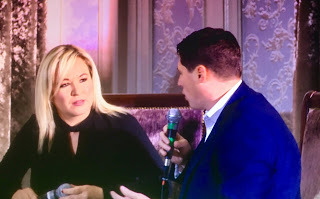 The issue of a referendum on unity is now centre stage. No other generation of Irish republicans has had this opportunity to end the union and partition. The men and women of 1916 had no such mechanism. Neither did Bobby Sands or Mairead Farrell and their contemporaries. Despite resistance from both governments and the main unionist parties a referendum WILL be held in the next few years. The drivers for this are the demographic changes in the north, the politicisation of sections of the community there, the focus on rights which are being denied by a DUP led minority and Brexit. Brexit is also the accelerant. Demographic trends suggest a nationalist voting majority in the north is close. Political unionism has lost its electoral majority in four consecutive elections and the exit poll conducted across the 26 counties in the wake of the Local Government and European elections show a huge majority in support of Irish unity.Brexit has forced many to consider their constitutional future. We are seeing increasing contributions to the unity debate from a wide variety of people, with many citing Brexit as a catalyst for their considerations. Our responsibility as republicans and democrats is to grasp this opportunity.
The issue of a referendum on unity is now centre stage. No other generation of Irish republicans has had this opportunity to end the union and partition. The men and women of 1916 had no such mechanism. Neither did Bobby Sands or Mairead Farrell and their contemporaries. Despite resistance from both governments and the main unionist parties a referendum WILL be held in the next few years. The drivers for this are the demographic changes in the north, the politicisation of sections of the community there, the focus on rights which are being denied by a DUP led minority and Brexit. Brexit is also the accelerant. Demographic trends suggest a nationalist voting majority in the north is close. Political unionism has lost its electoral majority in four consecutive elections and the exit poll conducted across the 26 counties in the wake of the Local Government and European elections show a huge majority in support of Irish unity.Brexit has forced many to consider their constitutional future. We are seeing increasing contributions to the unity debate from a wide variety of people, with many citing Brexit as a catalyst for their considerations. Our responsibility as republicans and democrats is to grasp this opportunity.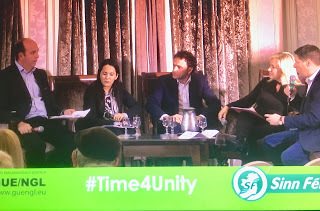
Published on October 11, 2019 08:36
October 3, 2019
Climate Justice now
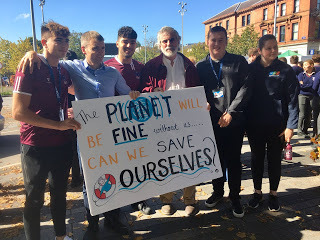 Two weeks ago the Court House Square in Dundalk was alive with the chants of young people from a variety of Dundalk secondary schools as they gave voice to their concern about the impact of climate change. They were demonstrating their fears about the future of humanity, and demanding that more is done to save the planet. These students represent the millions of young people, in scores of countries around the world, who took part in a global day of action to raise awareness about climate change. Their enthusiasm, energy, and commitment to this campaign is inspirational.
Two weeks ago the Court House Square in Dundalk was alive with the chants of young people from a variety of Dundalk secondary schools as they gave voice to their concern about the impact of climate change. They were demonstrating their fears about the future of humanity, and demanding that more is done to save the planet. These students represent the millions of young people, in scores of countries around the world, who took part in a global day of action to raise awareness about climate change. Their enthusiasm, energy, and commitment to this campaign is inspirational.The speeches In Dundalk were thoughtful, informed, direct and a warning of the threat climate change poses to us all and to our families and the billions whose lives are already being changed every day by the damaging effects of human pollution.
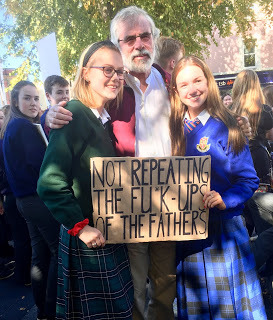 A few days later, speaking in New York at a UN climate change summit, Greta Thunberg berated the political leaders of the world for failing to honour past agreements on climate change and failing to set new urgently needed new targets for reversing the current trend toward complete climate breakdown. In a powerful and emotional speech Thunberg accused governments of failing humanity and warned of “the beginning of a mass extinction. And all you can talk about is money and fairytales of eternal economic growth. How dare you!“For more than 30 years the science has been crystal clear. How dare you continue to look away and come here saying that you are doing enough, when the politics and solutions needed are still nowhere in sight.“You are failing us, but the young people are starting to understand your betrayal. The eyes of all future generations are upon you and if you choose to fail us, I say: We will never forgive you.“We will not let you get away with this. Right here, right now is where we draw the line. The world is waking up and change is coming, whether you like it or not.”
A few days later, speaking in New York at a UN climate change summit, Greta Thunberg berated the political leaders of the world for failing to honour past agreements on climate change and failing to set new urgently needed new targets for reversing the current trend toward complete climate breakdown. In a powerful and emotional speech Thunberg accused governments of failing humanity and warned of “the beginning of a mass extinction. And all you can talk about is money and fairytales of eternal economic growth. How dare you!“For more than 30 years the science has been crystal clear. How dare you continue to look away and come here saying that you are doing enough, when the politics and solutions needed are still nowhere in sight.“You are failing us, but the young people are starting to understand your betrayal. The eyes of all future generations are upon you and if you choose to fail us, I say: We will never forgive you.“We will not let you get away with this. Right here, right now is where we draw the line. The world is waking up and change is coming, whether you like it or not.”
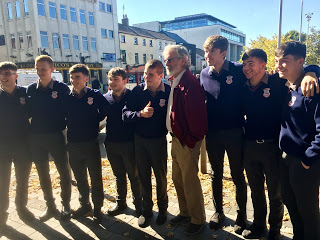 Her warnings of government failure were underlined at the UN summit by the refusal of several of the world’s worst polluters to take part in the climate summit, among them the USA and Brazil. The burning of the Brazilian Amazon rain forest – often referred to as the lungs of the planet - has been a cause of major concern in recent months. China failed to present any new proposals to tackle climate change and India made no commitment on phasing out coal.
Her warnings of government failure were underlined at the UN summit by the refusal of several of the world’s worst polluters to take part in the climate summit, among them the USA and Brazil. The burning of the Brazilian Amazon rain forest – often referred to as the lungs of the planet - has been a cause of major concern in recent months. China failed to present any new proposals to tackle climate change and India made no commitment on phasing out coal.The Science Advisory Group to UN Climate Action Summit 2019 produced a report for the UN summit – United in Science. It brings together the most recent data from the world’s six leading environmental organisations. It is an all-too depressing picture of failure by governments and increasing threats to humanity. The report found that if the world is to meet the 2015 Paris agreement goal of holding the temperature to 1.5C then current plans to cut planet-warming gases must be increased by between three and five fold. Some of its more serious warnings are:· 2015–2019 is on track to be the warmest of any equivalent period on record.· Widespread and long-lasting heatwaves, record-breaking fires and other devastating events such as tropical cyclones, floods and drought have had major impacts.· Arctic summer sea-ice extent has declined at a rate of approximately 12% per decade during 1979-2018. The four lowest values for winter sea-ice extent occurred between 2015 and 2019.· The sea level is rising faster than ever before.· Levels of the main long-lived greenhouse gases, carbon dioxide (CO2), methane (CH4)) and nitrous oxide (N2O) have reached new highs.
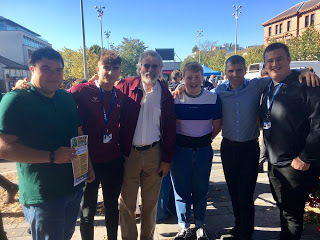 Last October the UN Intergovernmental Panel on Climate Change (IPCC) warned that we have only 12 years to limit climate change before the people of the world face extreme droughts, heat, floods, increased food insecurity and water supply, and increased poverty for hundreds of millions of citizens.The National Biodiversity Data Centre in Waterford reports that one third of the bee species on the island of Ireland – which are essential for pollination – is either regionally extinct or vulnerable.The evidence is overwhelming. Humanity faces greater challenges than ever before. Without resolute action millions are at risk. Failure to achieve the 1.5C rise will see many coastal areas being flooded, including Belfast and coastal towns like Dundalk. Our future, our children and grandchildren’s futures depend on the decisions we take now as a society. Moreover, any strategies to tackle climate change must be rooted in the principles of social justice and equality.Governments, including the Irish government and the EU, need to significantly step up our climate change commitments and challenge the big polluters. Market solutions haven’t worked. Carbon taxes don’t work. It’s also time to significantly curtail the influence of the big oil and gas companies.
Last October the UN Intergovernmental Panel on Climate Change (IPCC) warned that we have only 12 years to limit climate change before the people of the world face extreme droughts, heat, floods, increased food insecurity and water supply, and increased poverty for hundreds of millions of citizens.The National Biodiversity Data Centre in Waterford reports that one third of the bee species on the island of Ireland – which are essential for pollination – is either regionally extinct or vulnerable.The evidence is overwhelming. Humanity faces greater challenges than ever before. Without resolute action millions are at risk. Failure to achieve the 1.5C rise will see many coastal areas being flooded, including Belfast and coastal towns like Dundalk. Our future, our children and grandchildren’s futures depend on the decisions we take now as a society. Moreover, any strategies to tackle climate change must be rooted in the principles of social justice and equality.Governments, including the Irish government and the EU, need to significantly step up our climate change commitments and challenge the big polluters. Market solutions haven’t worked. Carbon taxes don’t work. It’s also time to significantly curtail the influence of the big oil and gas companies.Greta Thunberg has become the conscience and voice of a generation angry at the destruction of our environment. She is articulate, formidable, authoritative and a gifted speaker. She knows the science. While a plethora of international reports over recent decades, and claims by hundreds of scientists and scientific bodies, have failed to mobilise mass demonstrations in defence of our world this teenage Swedish climate activist has succeeded in galvanising public awareness and encouraging climate activism in an unparalleled way.
She has also become the target of a vicious, shameful, often personalised campaign of hate from climate deniers fearful of her growing influence and unable to rebut the science. Speaking last week to an estimated half a million at a rally in Montreal she said that: "I guess they must feel like their world view or their interests or whatever... is threatened by us. We've become too loud for people to handle so they try to silence us ... We should also take that as a compliment."Two weeks ago, and in the days since, young people in cities across the world have shown the way forward. Their example must guide us in the time ahead.
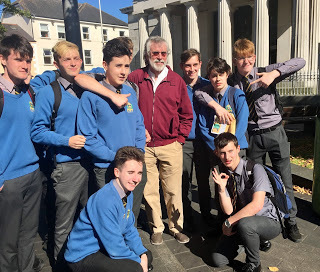
Published on October 03, 2019 03:47
September 27, 2019
Celebrating 100 years of partition?
Three months ago, during the July marches and rallies by the Orange Order, the DUP declared that the centenary of the northern state in 2021 should be a public holiday and a source of celebration
Published on September 27, 2019 02:00
September 21, 2019
Celebrating the Champions of US Labor
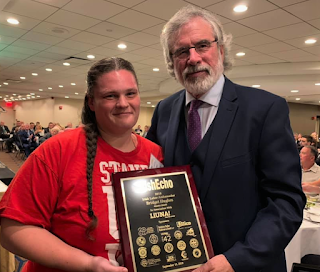
Presenting Bridget Hughes with her award
I want to thank the staff of Aer Lingus in Dublin and New York who pulled out all of the stops last week to ensure that RG and I succeeded in getting to and from New York. As regular readers will know navigating the rules and regulations that are often applied to Sinn Féin representatives travelling to America can be problematic.Last Thursday morning, we presented our passports to the Aer Lingus desk in Dublin Airport just before 8am. We eventually took to the air New York bound shortly after 3 pm. 25 years ago when I first visited New York on President Clinton’s 48 hour visa one of those who met me at the airport was Brian McCabe – then a detective in the NYPD. Now retired from that force Brian was at Newark to pick us up. It’s always good to see a friendly face after a long day of travelling.The visit itself to New York was very good. It was short – just two nights. It gave me an opportunity to meet with some of the senior trade union leaders who visited Belfast in April for the opening by President Michael D Higgins of Áras Uí Chonghaile – the James Connolly Visitor Centre. However, the main purpose for travelling to New York was to speak at the ninth annual Irish Echo Labor Awards. They are a celebration of the hard work of Trade Unions in North America and of Labor activists in improving the working and living conditions of their members.All of the honourees are ordinary people who in the course of their work have provided leadership and inspiration to others. One honouree was so nervous that he had difficulty reading his note. He was given a rousing reception. Another, Bridget Hughes, a shift worker at McDonald’s in Kansas City gave a stirring speech about the challenges facing low paid – low wage workers. Hughes led the Stand Up Kansas City campaign which successfully secured a $15 minimum wage campaign. Hughes, 28, a mother of three, took part in civil disobedience protests in 2016 and was imprisoned for her efforts.
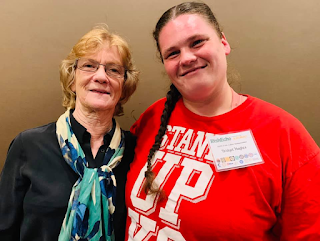 Bridget said: “If we raise wages, it puts more money in workers’ hands and that goes into the local economy. As the working class, we need to fight for vision for America. No matter if you’re white, black or brown, gay or straight, immigrant or native-born, we must come together so that we can go up together as workers. This is the new American working class identity our country so desperately needs.”Bridget told her audience that she only read about James Connolly when she was researching for her remarks for the Echo awards. She was deeply impressed by his commitment to workers and referring to him throughout her remarks as ‘Mr. Connolly’ Bridget said: “So many of his words still ring true to me. We are trying to build a new 21st century Union movement and we have to follow Mr. Connolly’s example. It is up to ordinary people – the working class - to organise to solve working peoples’ problems.”Speaking to Bridget afterward I told her that I hoped we could arrange for her to visit Áras Uí Chonghaile in the future.I always come away from my visits to the USA uplifted. This visit was no exception.
Bridget said: “If we raise wages, it puts more money in workers’ hands and that goes into the local economy. As the working class, we need to fight for vision for America. No matter if you’re white, black or brown, gay or straight, immigrant or native-born, we must come together so that we can go up together as workers. This is the new American working class identity our country so desperately needs.”Bridget told her audience that she only read about James Connolly when she was researching for her remarks for the Echo awards. She was deeply impressed by his commitment to workers and referring to him throughout her remarks as ‘Mr. Connolly’ Bridget said: “So many of his words still ring true to me. We are trying to build a new 21st century Union movement and we have to follow Mr. Connolly’s example. It is up to ordinary people – the working class - to organise to solve working peoples’ problems.”Speaking to Bridget afterward I told her that I hoped we could arrange for her to visit Áras Uí Chonghaile in the future.I always come away from my visits to the USA uplifted. This visit was no exception.
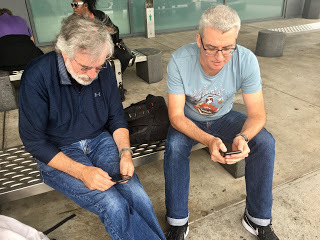 Unfortunately our flight home coincided with the all-Ireland replay between Kerry and Dublin. So, myself, RG and Ciaran sat outside Terminal 5 at JFK huddled over our mobile phones and trying to listen to the online RTE radio coverage as planes roared overhead. It was an exciting game. The five in a row Dublin team are an exceptional group of athletes. Well deserved winners and although Kerry did their best it was not to be. The best team won. Fair play to both panels of players and management. This week sees the Houses of the Oireachtas reopening for business after the summer break. The two big issues which will dominate the political agenda over the next few weeks will be Brexit and the Budget. But those are matters for me to write about another time. In the meantime I am searching for my suitcase. As I file this column it is still missing. A victim of the dreaded SSSS my valise has gone AWOL. I’m sure it will turn up eventually. By then my laundry and especially my under garments will be rather stale. Minty! Awh the struggle - My flight for Irish freedom - has its cost. Tiochfaidh mo mhála.
Unfortunately our flight home coincided with the all-Ireland replay between Kerry and Dublin. So, myself, RG and Ciaran sat outside Terminal 5 at JFK huddled over our mobile phones and trying to listen to the online RTE radio coverage as planes roared overhead. It was an exciting game. The five in a row Dublin team are an exceptional group of athletes. Well deserved winners and although Kerry did their best it was not to be. The best team won. Fair play to both panels of players and management. This week sees the Houses of the Oireachtas reopening for business after the summer break. The two big issues which will dominate the political agenda over the next few weeks will be Brexit and the Budget. But those are matters for me to write about another time. In the meantime I am searching for my suitcase. As I file this column it is still missing. A victim of the dreaded SSSS my valise has gone AWOL. I’m sure it will turn up eventually. By then my laundry and especially my under garments will be rather stale. Minty! Awh the struggle - My flight for Irish freedom - has its cost. Tiochfaidh mo mhála.
Published on September 21, 2019 04:00
September 12, 2019
New York – New York
By the time you are reading this column RG and I will be winging our way across the Atlantic to New York for a two night stopover. I am there to speak at the Irish Echo Labor awards. It’s an annual event at which the trade union movement in the USA, and the Irish Echo, celebrate the hard work and achievements of individual Labor activists and honourees.
It is also be an opportunity for me to personally thank many of the Trade Union leaders for their continued support for the peace process, and in particular for their backing of Áras Uí Chonghaile (The James Connolly Centre on the Falls Road) which was opened in April of this year by President Michael D Higgins. The US Labor Movement provided much needed funding, along with Belfast City Council and others, to turn the dream of Áras Uí Chonghaile into a reality.
It’s hard to believe but it is almost exactly 25 years since RG and I made the first of many such visits to the USA. At that time, and within days of the IRA cessation of August 1994, I had just met An Taoiseach Albert Reynolds and SDLP Leader John Hume at Government Buildings in Dublin. Border communities moved quickly to unblock scores of border crossings that the British military had bombed or concreted over the years. And RG and I were on our way to the USA for a four week trek – coast to coast – to meet Irish American leaders and communities. Subsequently, the British Prime Minister John Major was moved to lift the broadcast restrictions on Sinn Féin. It was a decision taken in no small part because of the influence of Irish America and the criticism of US journalists.25 years later and Irish America continues to play apivotal role in the efforts to strength the peace process and to advance the Sinn Féin goal of Irish unity. The Labor Movement in the USA is a critical component of Irish America. That influence has been especially evident in recent months in the lobbying by Irish American groups and leaders around the Brexit issue and the need for a referendum on Irish Unity. On Capitol Hill their efforts secured support for the so-called ‘Backstop.’ The opposition of key Congressional leaders to British and DUP efforts to undermine the Good Friday Agreement has been very public. One recent example of this was the intervention by Speaker Nancy Pelosi in which she again rejected suggestions of a speedy trade deal between the USA and British government following Brexit. Speaker Pelosi said: “The Good Friday Agreement serves as the bedrock of peace in Northern Ireland and as a beacon of hope for the entire world… Whatever form it takes, Brexit cannot be allowed to imperil the Good Friday Agreement, including the seamless border between the Irish Republic and Northern Ireland, … If Brexit undermines the Good Friday accord, there will be no chance of a U.S.-U.K. trade agreement passing the Congress.”
This has been reinforced by Congress members, including Richie Neal, who is the Chair of the powerful Congressional Ways and Means Committee.
25 years ago our journey brought us to Boston where we were greeted by Senator Ted Kennedy. On Thursday we arrive at JFK airport in New York. As we land the debacle over Brexit at Westminster gets worse. An unelected minority government, with an unelected Prime Minister at its head, is seeking to reshape the British political landscape in a way that will further its right wing, populist, agenda. Claims of shock and outrage that Johnson will ignore the law - just passed requiring him to seek an extension from the EU for negotiations - rings hollow to Irish citizens who can recall countless occasions when British governments – both Tory and Labour - ignored their own laws and international laws in their dealings with Ireland.
The economic, political and social threats posed by British machinations to the island of Ireland are enormous. Another economic report last week predicted thousands of job losses in the North. Last Thursday An Taoiseach Leo Varadkar told the British-Irish Chamber of Commerce that checks on goods entering the South would be required “near the Border” in the event of a no-deal Brexit. He also confirmed that the government is in discussions with the European Commission over what cross-border checks will be required. He should be making it clear that there will be no checks anywhere on the island of Ireland.
In addition, at this most critical time the reality is that despite the best efforts of Sinn Féin there are no meaningful discussions taking place at this time with the DUP to restore the political institutions in the North. The DUP is singularly focussed on its alliance with Boris Johnson and the Conservative Party.So, and not for the first time, the peace process, and the island of Ireland is in dangerous waters. The chaos of Brexit has once again confirmed that Irish interests are not British interests.At the same time the political and economic uncertainty and the deeply corrupt nature of British politics, exposed by this crisis, has created, once again discussions on the merits of Irish Unity. It is an argument I take with me to our friends in the USA.
Published on September 12, 2019 18:39
September 6, 2019
Hugs Galore.

Fr. DesDear reader, have you have noticed that republican men of a certain age are nowadays more inclined than their predecessors were to hug other men, including other republican men of a certain age? I want to take credit for this very welcome development. I have long been a champion of hugging. It is a warmer, more-friendly form of greeting than handshaking. Handshaking is formal. Hugging is more natural. Instinctive. Wee babies don’t shake hands with you when you greet them. No. If they like you they hug you. People with Downs syndrome do the same. They are wonderfully welcoming and affectionate folks. They could teach us a lot. Latino people hug. Normally macho companeros do it all the time. Irish men? Nawh. So I’ve had my work cut out for me.
Ask RG? He will vouch for my credentials over decades of this pioneering work. He will also advise you if you press him that for a long time this was a lonely and challenging task for me. He may even admit that he frowned upon and resisted my efforts to hug other men. Especially him. Martin McGuinness was the same. They weren’t so bad when they realised that my efforts were completely platonic. So occasionally maybe they would indulge me. The odd time. But only if no one else was about. Hugging in public was a Never, Never, Never occurrence. But thankfully all that has changed.
 Hugging Bernie I remember once, before he embraced hugging, Martin and I were meeting with David Trimble and Ken McGuinness. John Taylor may have been there also. Or maybe not? But there was a barge pole leaning against the meeting room wall. Anyway we were having a difficult conversation with a lot of grumpiness from our friends. Then one of them flung a document down on the table. We all rose to our feet glowering at each other for a few awkward red faced seconds.
Hugging Bernie I remember once, before he embraced hugging, Martin and I were meeting with David Trimble and Ken McGuinness. John Taylor may have been there also. Or maybe not? But there was a barge pole leaning against the meeting room wall. Anyway we were having a difficult conversation with a lot of grumpiness from our friends. Then one of them flung a document down on the table. We all rose to our feet glowering at each other for a few awkward red faced seconds.“I think we need a group hug” I suggested opening my arms wide.
“No” said Martin and David in unison. And agreement. No hug here.
It’s funny how other male adversaries hug regularly. Especially sports men. Gaelic footballers or hurlers take big hits off one and other. Then when the final whistle blows what do they do? They hug each other. Boxers do the same. Rugby players too.
So, I never gave up on my hugging mission. I stuck with it. RG was my first convert. Although he is an awkward hugger. At least with me. He doesn’t do full frontal hugs. He is a hip hugger. No groin contact. He swivels his hip forward so that part of his anatomy meets you at a right angle. Although to be fair his upper body embrace is warm and welcoming.At least with me.
Martin McGuinness followed suit. Soon he was hugging everyone in arms length. Nothing too aggressive. More a very respectful and chuckleyarlácuddley bear hug. I think that’s one of the reasons why Martin was so popular. So hugging is good. It helps to break the ice. Unless your breath is bad. That can be offputting.
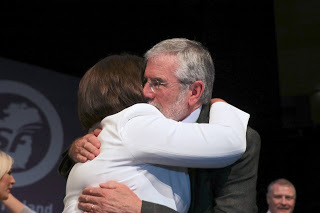 Mary Lou is a huggerI think that’s why most unionists don’t hug me. I eat a lot of garlic. Garlic and hugging are not very compatible. But discerning readers will note that I say MOST unionists don’t hug me. That’s right. I didn’t say no unionists hug me. Because some do. Not a lot but fear not. Remember it isn’t that long ago that most republican men wouldn’t hug other men. Ted still resists my overtures. I blame the Catholic in him. Trees have more give in them. So my work continues. And no. I won’t name my unionist hugger mates. In time we will all take these little human embraces for granted. Until then let’s help them by making men hugging men popular. If you know Ted give him a wee squeeze. Ease him into a group hug.
Mary Lou is a huggerI think that’s why most unionists don’t hug me. I eat a lot of garlic. Garlic and hugging are not very compatible. But discerning readers will note that I say MOST unionists don’t hug me. That’s right. I didn’t say no unionists hug me. Because some do. Not a lot but fear not. Remember it isn’t that long ago that most republican men wouldn’t hug other men. Ted still resists my overtures. I blame the Catholic in him. Trees have more give in them. So my work continues. And no. I won’t name my unionist hugger mates. In time we will all take these little human embraces for granted. Until then let’s help them by making men hugging men popular. If you know Ted give him a wee squeeze. Ease him into a group hug.Start now lads. Hug the men in your life. It will do you and them good.
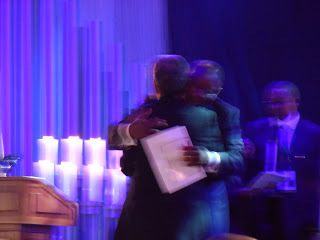 Cyril Ramaphosa at funeral of President Mandela
Cyril Ramaphosa at funeral of President Mandela
Published on September 06, 2019 03:44
August 28, 2019
The 94 Cessation – how it happened
The IRA cessation is 25 years old this week. August 1994 was an intense month. I was involved, along with Martin McGuinness, and others in the Sinn Féin leadership, in intense, mostly private, efforts to persuade the SDLP Leader John Hume, the Irish Government and allies in Irish America to establish an alternative unarmed strategy to pursue republican and democratic objectives. Fr Alec Reid was central to this. And Fr Des. The Sinn Féin aim was to open up the opportunity for a meaningful peace process that could bring about fundamental political and constitutional change. At the same time we were intent on advancing our republican objectives of ending partition and bringing about Irish Unity.August 1994 was the month when it all began to come together. To be honest, neither Martin nor I really knew if we would succeed. We were attempting something unique and exceptional - to construct a series of agreements which together could persuade the IRA leadership that there existed an alternative to armed actions capable of achieving republican goals. The danger was that if we pulled everything together and the Army said NO then the process was over before it really startedOur discussions involved the Irish government; I was meeting John Hume; we were negotiating with the US administration through a variety of channels, and there was a delegation of Irish Americans – the Connolly House group – who were lobbying the Clinton administration to develop a new Irish agenda. We were also in contact with the British government though they were not part of the effort to develop an alternative. At a briefing in early August with the IRA leadership Martin was able to tell it that the Irish government had provided written assurances that if there was a cessation there would be an immediate response on practical matters. Sinn Fein would be treated like any other political party. This would include a speedy meeting between the Taoiseach, Albert Reynolds, myself and John Hume. Incidentally, after the cessation was declared and before that meeting Albert contacted me to say that Seamus Mallon had asked him to put our meeting back until he met with John Hume and Seamus. I dismissed this. The Taoiseach did not press it. The Connolly House group had also passed back to us a document which set out a serious programme of work and commitment from them and Irish America. Entitled ‘Policy Statement by Irish American leaders’ it said that in the event of a ceasefire they would commit themselves to ‘the creation of a campaign in the United States dedicated to achieving’ a number of specified goals. Among these were an immediate end to all visa restrictions and the provision of unrestricted access for the Sinn Fein party leader.The IRA leadership listened attentively to what we had to say. It agreed to meet again to receive an update from us. It was coming close to make your mind up time. Everyone at the meeting knew this. Some of the leadership were against a cessation. They had been very frank about that. It was going to be a close call.I believed that we had to choreograph a series of statements, actually more public initiatives than statements, from John Hume, An Taoiseach Albert Reynolds, and the Connolly House group, which would signal the coming together of the different pieces of the jig-saw. We also needed a visa for Joe Cahill. It was one of the issues which the Army leadership had raised with us. Fundamentally it was a test to see if the Irish government was prepared to take on the British and if it could win such a political battle with the British within the US administration. It would also be an important indicator of how seriously the Clinton administration intended to take the issue of peace in Ireland.The Connolly House Group returned to Ireland on August 25. The following Sunday John Hume and I met and issued another joint statement. Later that evening the Taoiseach, Albert Reynolds issued a statement in which he also expressed a belief that a historic opportunity was opening up.Martin and I met the Army Council again. The meeting was inconclusive. People needed more time to consider all the issues. Joe’s visa became an even greater test. Then late on Monday night, August 29th, President Clinton cleared Joe’s visa.Martin and I again travelled to meet the Army Council. A package had been agreed. It was now over to the IRA leadership. Everyone at the Army meeting was a little tense. Martin McGuinness spoke eloquently. So did others. For and against.One of Martin’s great qualities was his sense of conviction and confidence. He could bring a strength to a debate which was very, very compelling. Even if you might not agree with him you knew he was going to deliver on any commitment he made or die trying. The struggle wasn’t ending we told them. They knew that of course.In many ways, I said, the easy decision was for the IRA to continue to fight. That was the low risk option. The high-risk option was the one we were arguing for. It meant uncharted waters. It would involve compromises. It could mean risking – and losing – everything. But we could also be the generation who would win freedom. We could set in place a process which could create new conditions for a genuine and just peace and from there build a pathway and a strategy into a new all Ireland republic.A formal proposal was then put to the meeting. The vote was for a cessation. It was not unanimous but those who voted against pledged their support to the new position. Unity, they said was essential.On Wednesday August 31st at noon the IRA declared its “complete cessation of military operations… We believe that an opportunity to create a just and lasting settlement has been created”.The peace process and the dramatic changes that have taken place in the last 25 years owe much to the courageous decision by the Army Council and those other Volunteers who followed the path chosen by the IRA leadership.A quarter of a century later much has changed. Ongoing political and demographic changes have increased the demand for more change. Political Unionism has lost its majority in the Assembly. Nationalism has rejected Westminster. There is a greater confidence and optimism. The demand for equality, for rights for all citizens is now part of our DNA. Support for a referendum on Irish Unity is growing. Nationalists and republicans will never again tolerate a second class status. Many within unionism have also come to accept the need for power-sharing and reconciliation and inclusiveness. And some are publicly speaking for the first time about the possibility of a new Ireland, a shared space which embraces the unity of all our people.There are of course still challenges to be overcome. Brexit looms. The power sharing government is not functioning. There are still those within political unionism who see everything as a zero sum game in which any change – however innocuous – is a defeat. The British government is allied to the DUP and refusing to honour commitments made when the Good Friday Agreement was achieved. The Irish government and the southern political establishment could do much more to fulfill their obligations as co-guarantor of the Agreement. So, there is still much work to be done.Looking back twenty five years ago to that period of our history and experience it is clear that dialogue, inclusive and based on equality, is central to any conflict resolution process – to any process of change. It is very telling that the then Leader of Unionism James Molyneaux described the cessation as ‘The most destabilising event since partition.’ Twenty five years later this assertion remains an insightful reminder of the worm at the heart of political unionism. That is the fear of positive political change. It is self-evident now that if it had been left to the Unionist leaders and the British Government there would have not been a cessation.
Thankfully they did not have a vote at the IRA’s Army Council meeting which took that decision”.
Published on August 28, 2019 15:02
August 23, 2019
Three Books and a Video about August 1969.
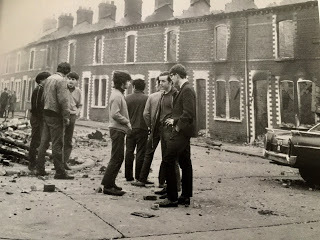
The second week of August 50 years ago witnessed the most intensive and violent period of conflict in the North since the 1920s. It also saw British soldiers arrive on the streets of Derry and Belfast, where they remained for another 30 years. The fighting in Derry, and the widespread destruction of homes in Belfast, revealed in all their stark brutality the deeply sectarian nature of the northern state and exposed the institutional links between the unionist political establishment, its armed state forces and loyalist paramilitary organisations.Several recent publications have been produced about August 1969. They include ‘Burnt Out; How the Troubles began’ by Michael McCann, and two books of photographs, ‘Ardoyne - The Aftermath’ and ‘Bombay Street’.The Clonard Residents Association has also produced an excellent video film; Eyewitness- The Burning of Bombay Street, which uses filmed reports of the time, including interviews with victims - to provide an excellent report of those even. In particular, the video also makes use of an audio homily given by Fr. Egan of Clonard Monastery, to the men’s confraternity, a few days after the attack on Clonard by loyalist mobs and B Specials. Fr. Egan also expresses his gratitude for the courage of the young men and women who defended the area. The video is available on youtube at: https://youtu.be/j5_qn19h3WM
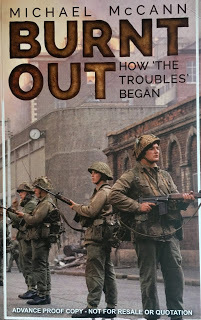 ‘Burnt Out’ is a detailed, hugely informative, and well researched book which reminds us of the context for August 1969. As a 14-year-old Michael McCann and his family were one of over three thousand families who were forced to flee when loyalist mobs, the B Specials and RUC attacked Catholic streets in west and North Belfast.He reminds us that over the two days of the 14th and 15th August eight civilians were killed. Seven – including two children - died in Belfast and one person was shot dead by the B Specials in Armagh. The first British soldier to be killed was Hugh McCabe, a 20-year-old home on leave who was shot dead by RUC snipers from the roof of Hasting Street Barracks.In his meticulously researched account of August 1969 McCann provides the most comprehensive explanation of that period. McCann is very blunt about his purpose in writing the book: “The main aim of my book is to highlight the relationship produced between reactionary loyalism, state forces and the unionist regime in the conflagration that erupted in the summer of 1969, which arguably generated three decades of subsequent violence”.McCann also reminds us of one tactic frequently employed by the RUC, political unionism and the British state throughout the decades of conflict – blame the victim for their oppression. As Catholic homes burned in Belfast the Stormont regime and the RUC spuriously claimed that it was all part of a nationalist rebellion. Despite the clear evidence that the Belfast pogrom was the work of loyalist mobs assisted by the RUC and B Specials, the Special Powers Act was invoked, and 24 republicans were interned.A few days after the destruction of Bombay Street, Percy Street, Conway Street, Hooker Street, Herbert Street and more, four Ulster Unionist Party Stormont
‘Burnt Out’ is a detailed, hugely informative, and well researched book which reminds us of the context for August 1969. As a 14-year-old Michael McCann and his family were one of over three thousand families who were forced to flee when loyalist mobs, the B Specials and RUC attacked Catholic streets in west and North Belfast.He reminds us that over the two days of the 14th and 15th August eight civilians were killed. Seven – including two children - died in Belfast and one person was shot dead by the B Specials in Armagh. The first British soldier to be killed was Hugh McCabe, a 20-year-old home on leave who was shot dead by RUC snipers from the roof of Hasting Street Barracks.In his meticulously researched account of August 1969 McCann provides the most comprehensive explanation of that period. McCann is very blunt about his purpose in writing the book: “The main aim of my book is to highlight the relationship produced between reactionary loyalism, state forces and the unionist regime in the conflagration that erupted in the summer of 1969, which arguably generated three decades of subsequent violence”.McCann also reminds us of one tactic frequently employed by the RUC, political unionism and the British state throughout the decades of conflict – blame the victim for their oppression. As Catholic homes burned in Belfast the Stormont regime and the RUC spuriously claimed that it was all part of a nationalist rebellion. Despite the clear evidence that the Belfast pogrom was the work of loyalist mobs assisted by the RUC and B Specials, the Special Powers Act was invoked, and 24 republicans were interned.A few days after the destruction of Bombay Street, Percy Street, Conway Street, Hooker Street, Herbert Street and more, four Ulster Unionist Party Stormont
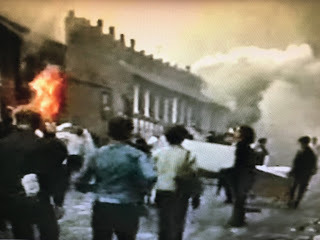 Ministers held a press conference on Sunday 17th August to outline their view of the events of recent days. McCann records that the international and local media covering the press conference “listened in disbelief” as the Unionist Ministers tried to blame the Catholic victims of the pogrom. This included a claim that families had burned their own homes.McCann writes: “When one reporter pointed out to the Education Minister, Captain Long, that ‘Protestants had gone into one area and burnt sixty-seven houses ‘and that his ‘own investigation’ suggested that 200 Catholic houses had been burned, Long breathtakingly replied that ‘a tremendous amount of those fires have been started within those areas which were sealed off by the Catholic population themselves… When asked by a journalist to whom information for a potential inquiry should be given, the Minister of Home Affairs, Robert Porter, replied: ‘to the police’, at which point ‘almost the entire hall burst into laughter.’”But unionists were deadly serious in their desire to defend their aggressive actions by blaming Catholics. According to McCann the Rev. Martin Smyth, a leading Orangeman claimed that “most Roman Catholics left at their own wishes. Some fired their own homes.”
Ministers held a press conference on Sunday 17th August to outline their view of the events of recent days. McCann records that the international and local media covering the press conference “listened in disbelief” as the Unionist Ministers tried to blame the Catholic victims of the pogrom. This included a claim that families had burned their own homes.McCann writes: “When one reporter pointed out to the Education Minister, Captain Long, that ‘Protestants had gone into one area and burnt sixty-seven houses ‘and that his ‘own investigation’ suggested that 200 Catholic houses had been burned, Long breathtakingly replied that ‘a tremendous amount of those fires have been started within those areas which were sealed off by the Catholic population themselves… When asked by a journalist to whom information for a potential inquiry should be given, the Minister of Home Affairs, Robert Porter, replied: ‘to the police’, at which point ‘almost the entire hall burst into laughter.’”But unionists were deadly serious in their desire to defend their aggressive actions by blaming Catholics. According to McCann the Rev. Martin Smyth, a leading Orangeman claimed that “most Roman Catholics left at their own wishes. Some fired their own homes.”
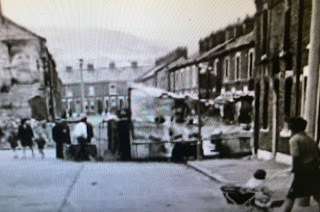 Between August and September it is estimated that 3,500 families fled from their homes in Belfast. 85% of them were Catholic.On the same date – August 14th - that the British Army was deployed on the streets of the North the British Home Secretary Jim Callaghan sent Robert Mark, Deputy Commissioner of the Metropolitan Police and Douglas Osmond, Chief Constable of Hampshire to Belfast to assess the policing situation. In a report to Callaghan they described the RUC as a “force apart‟. They also reported that at the first signs of trouble the RUC reverted to a paramilitary force where any opposition to the status quo was dealt with by force. Mark and Osmond concluded that the RUC was a sectarian agency whose role as an arm of the ruling Unionist party precluded it from performing the duties of an impartial police force.The new edition of ‘Bombay Street: Taken from the Ashes’ by Gerry Collins and ‘Ardoyne – the aftermath’ by Hugh McKeown provide a different perspective on August 69. These are two unique photographic accounts of the devastation inflicted on Catholic areas. The books are the work of Frankie Quinn – a Belfast photographer – and the Belfast Archive Project. Frankie who is a well-known and celebrated photographer in his own right recognised the unique significance of the photographs taken in by Gerry and Hugh.
Between August and September it is estimated that 3,500 families fled from their homes in Belfast. 85% of them were Catholic.On the same date – August 14th - that the British Army was deployed on the streets of the North the British Home Secretary Jim Callaghan sent Robert Mark, Deputy Commissioner of the Metropolitan Police and Douglas Osmond, Chief Constable of Hampshire to Belfast to assess the policing situation. In a report to Callaghan they described the RUC as a “force apart‟. They also reported that at the first signs of trouble the RUC reverted to a paramilitary force where any opposition to the status quo was dealt with by force. Mark and Osmond concluded that the RUC was a sectarian agency whose role as an arm of the ruling Unionist party precluded it from performing the duties of an impartial police force.The new edition of ‘Bombay Street: Taken from the Ashes’ by Gerry Collins and ‘Ardoyne – the aftermath’ by Hugh McKeown provide a different perspective on August 69. These are two unique photographic accounts of the devastation inflicted on Catholic areas. The books are the work of Frankie Quinn – a Belfast photographer – and the Belfast Archive Project. Frankie who is a well-known and celebrated photographer in his own right recognised the unique significance of the photographs taken in by Gerry and Hugh.
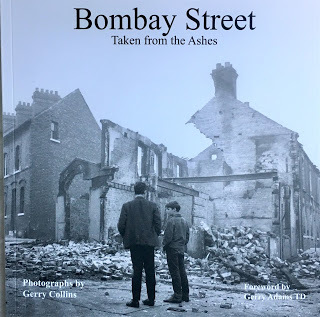 The morning after Bombay Street was destroyed on 15th August Gerry Collins walked to Bombay Street where his aunt lived. He brought his camera and three rolls of film. Later that week he went into other areas in the Falls and took more photographs of barricaded streets and burned out homes and buildings. It is a remarkable visual record of events of an extraordinary time in August 1969. They record the pain and the trauma for families suddenly left with nothing.
The morning after Bombay Street was destroyed on 15th August Gerry Collins walked to Bombay Street where his aunt lived. He brought his camera and three rolls of film. Later that week he went into other areas in the Falls and took more photographs of barricaded streets and burned out homes and buildings. It is a remarkable visual record of events of an extraordinary time in August 1969. They record the pain and the trauma for families suddenly left with nothing.
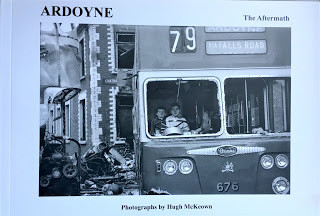 Hugh McKeown was an amateur photographer who was born in Ardoyne. He witnessed first-hand the horror of families being evicted from their homes and of streets destroyed in an orgy of violence by loyalists, the B Specials and the RUC. He helped evacuate his family from Brookfield Street. Hugh’s photos, like those of Gerry Collins, remind us of the personal, individual trauma that many families experienced that summer.
Hugh McKeown was an amateur photographer who was born in Ardoyne. He witnessed first-hand the horror of families being evicted from their homes and of streets destroyed in an orgy of violence by loyalists, the B Specials and the RUC. He helped evacuate his family from Brookfield Street. Hugh’s photos, like those of Gerry Collins, remind us of the personal, individual trauma that many families experienced that summer.
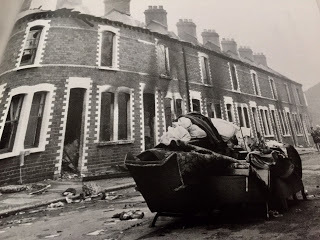 These three books and the Clonard Residents Association video are by people who were there. Go online for the Clonard video; ask for the books in your local library or bookshop. Or buy them online at Republican Merchandising LTD. 00 353 1 8726100: email address is sales@sinnfeinbookshop.com: orders@sinnfeinbookshop.com
These three books and the Clonard Residents Association video are by people who were there. Go online for the Clonard video; ask for the books in your local library or bookshop. Or buy them online at Republican Merchandising LTD. 00 353 1 8726100: email address is sales@sinnfeinbookshop.com: orders@sinnfeinbookshop.com
Published on August 23, 2019 05:46
Gerry Adams's Blog
- Gerry Adams's profile
- 29 followers
Gerry Adams isn't a Goodreads Author
(yet),
but they
do have a blog,
so here are some recent posts imported from
their feed.


